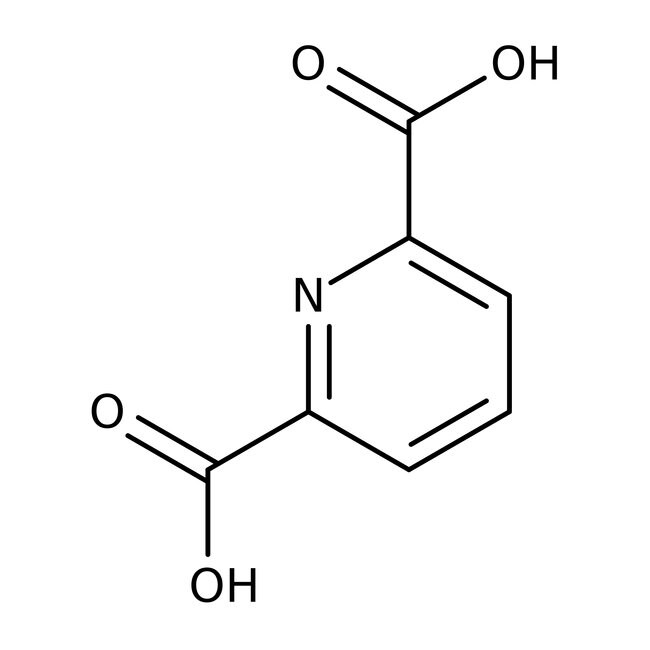Search Thermo Fisher Scientific
Thermo Scientific Chemicals
Pyridine-2,6-dicarboxylic acid, 98%, Thermo Scientific Chemicals
Catalog number: A12263.22
100 g, Each



Thermo Scientific Chemicals
Pyridine-2,6-dicarboxylic acid, 98%, Thermo Scientific Chemicals
Catalog number: A12263.22
100 g, Each
Quantity
Catalog number: A12263.22
also known as A12263-22
Price (USD)
Special offer:
71.65 84.40 Save 12.75 (15%)
Ends: 15-Oct-2024
Each
Quantity
-
Have Questions?
Chemical Identifiers
CAS
499-83-2
IUPAC Name
pyridine-2,6-dicarboxylic acid
Molecular Formula
C7H5NO4
InChI Key
WJJMNDUMQPNECX-UHFFFAOYSA-N
SMILES
OC(=O)C1=CC=CC(=N1)C(O)=O
Specifications
Appearance (Color)
White to pale cream
Form
Crystals or powder or crystalline powder
Assay (Aqueous acid-base Titration)
≥97.5 to ≤102.5% (Non-U.S. specification)
Assay (Silylated GC)
≥97.5% (Non-U.S. Specification)
Assay from Suppliers CofA
≥97.5% (HPLC, U.S. specification)
Description
Pyridine-2,6-dicarboxylic acid is used in the preparation of dipicolinato ligated lanthanide and transition metal complexes. It acts as a chelating agent for chromium, zinc, manganese, copper, iron and molybdenum. Its calcium-dipcolinic acid complex is used to protect deoxyribonucleic acid (DNA) from heat denaturation which enhances the DNA stability. It plays an important role as a marker for the effectiveness of sterilization.
This Thermo Scientific Chemicals brand product was originally part of the Alfa Aesar product portfolio. Some documentation and label information may refer to the legacy brand. The original Alfa Aesar product / item code or SKU reference has not changed as a part of the brand transition to Thermo Scientific Chemicals.
Applications
Pyridine-2,6-dicarboxylic acid is used in the preparation of dipicolinato ligated lanthanide and transition metal complexes. It acts as a chelating agent for chromium, zinc, manganese, copper, iron and molybdenum. Its calcium-dipcolinic acid complex is used to protect deoxyribonucleic acid (DNA) from heat denaturation which enhances the DNA stability. It plays an important role as a marker for the effectiveness of sterilization.
Solubility
Insoluble in water.
Notes
Incompatible with acids, bases and oxidizing agents.
Pyridine-2,6-dicarboxylic acid is used in the preparation of dipicolinato ligated lanthanide and transition metal complexes. It acts as a chelating agent for chromium, zinc, manganese, copper, iron and molybdenum. Its calcium-dipcolinic acid complex is used to protect deoxyribonucleic acid (DNA) from heat denaturation which enhances the DNA stability. It plays an important role as a marker for the effectiveness of sterilization.
Solubility
Insoluble in water.
Notes
Incompatible with acids, bases and oxidizing agents.
RUO – Research Use Only
Figures
Documents & Downloads
Certificates
Search by lot number or partial lot number
Frequently asked questions (FAQs)
Citations & References
Search citations by name, author, journal title or abstract text